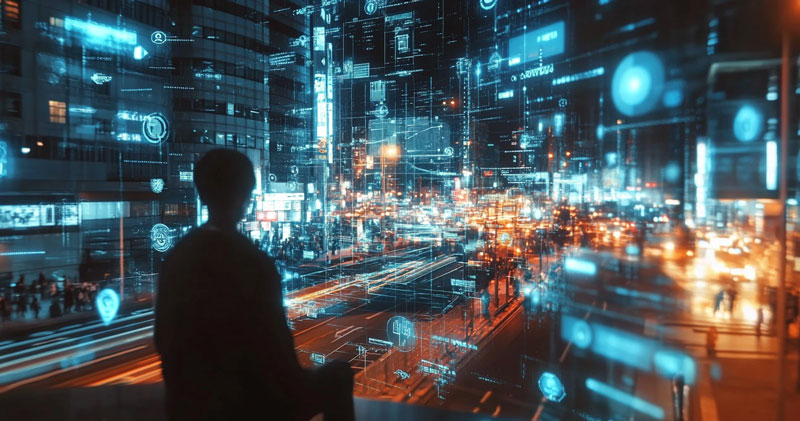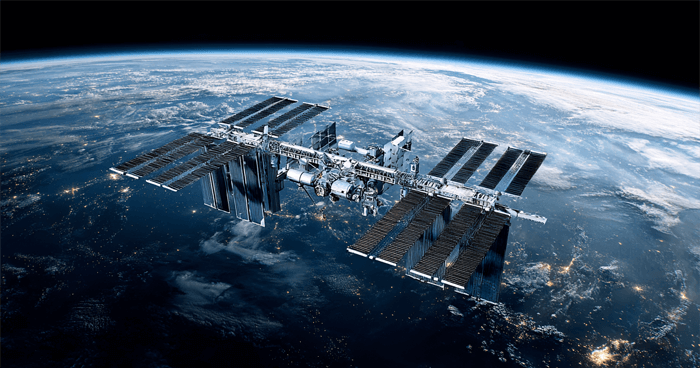
The Intersection of AI and Blockchain Technology
Let’s dive into today’s AMA…


A special thank you to all my readers who attended my AI Emergency Event this past week, with MarketWise founder and board member Porter Stansberry.
In the future, in addition to my daily writings to you here in The Bleeding Edge, I’ll continue hosting events like this to dive deeper into the biggest and most urgent tech megatrends I’m seeing… and the investible opportunities that these trends create for us.
My primary goal with these events is to deliver valuable information to my subscribers that you simply won’t find anywhere else. They will always be free to attend.
This time, I was able to share video of some of my travels in the field researching these massive AI factories that are being built around the country. Seeing what’s going on really helps put things into perspective.
Thank you to those of you who participated. I hope you got a lot out of it.
Let’s dive into today’s AMA – there’s never a shortage of topics to discuss. As a reminder, my team and I read each and every email. Please write to us here.
Looking forward to hearing from you.
Jeff
Investment Opportunities in the Fueling of Data Centers
Great article on power demand for data centers/AI. Thanks, Jeff, for the informative article. Any suggested investments that may thrive because of the huge power demand? Natural gas seems like the most likely transition fuel until more nuclear, wind, and solar can be built. Any opportunities there? Thanks.
– Carl B.
Hello Carl,
Yes, you’re correct about natural gas. It’s the fastest short-term solution to increasing electricity output and it’s the cleanest burning fossil fuel to use.
The bigger trend however in the data center industry – the growth of which is being powered by AI – is to co-locate new data center construction near nuclear power plants. Nuclear power has the benefit of having no emissions.
The reality is that none of the players in the data center or artificial intelligence industries are trying to reduce their energy consumption. They are trying to increase it to accelerate growth.
So they have to choose between coal, natural gas, or nuclear power. Wind and solar are not sufficient to guarantee the 24/7/365 increasing power demands of a massive data center facility.
And there has recently been a shift in political support for nuclear power. The very people that have held the nuclear power industry back for decades have recently warmed up to nuclear power. I wrote about this in Outer Limits – Has the Tide Turned on Nuclear Power?
One company that I recently wrote about that will benefit from this trend is Constellation Energy (CEG). It’s a more conservative investment, as it is the largest provider of nuclear power in the U.S., and it pays a dividend.
Depending on what happens with the election, this year will impact whether or not the natural gas industry will thrive or suffer. This will, of course, impact whether or not there will be great investment opportunities in this industry.
But no matter what happens with the election, I believe that the nuclear power industry will benefit. The energy industry will move further away from coal, and nuclear power is the only emission-free alternative capable of meeting the exponential growth in electricity demands due to artificial intelligence.
Parallel Processing Units: Buzzword or Real Deal?
Hi Jeff, has Flow Computing’s new breakthrough attracted your attention? Would like to get your analysis on this company’s new tech. Thanks.
– Sam W.
Hi Sam,
I’ve been keeping an eye on Flow Computing. Just as you have seen, the Helsinki-based company has been making some pretty big claims about its Parallel Processing Unit (PPU) that “amplifies CPU performance by up to 100 times.”
The company is designing a semiconductor architecture, the PPU, that Flow Computing envisions will work in collaboration with a CPU. A CPU will control the flow of tasks that need to be processed, and the PPU is capable of parallel processing of tasks, which is why the company claims that it can help CPUs accelerate their performance.
The idea also involves that the combined CPU and PPU will have a shared memory cache to increase speed and eliminate any coherency delays.
Before we get too excited, there is important context. Flow Computing just had its first institutional raise (seed round) this summer of $4.3 million. The company is tiny, and currently valued at $8.25 million. The VCs behind Flow Computing are Finland or Sweden-based, and there are no major VCs who specialize in computing technology invested in this company.
This is the kind of company that I might look at as an angel investor, or for the kinds of deals that I evaluate for Day One Investor at Brownridge Research. This is very early stage, and the company will have to raise a lot more capital to build out and prove its technology. And it will also need to partner with CPU companies to develop reference designs for its PPUs.
The Aftermath of AI
I consider the consequences of AI along with other astronomical power inventions. The buggy whip makers in the early 20th century needed to find other jobs when the car overtook buggies. Water and fire are useful, but they need care. My 81-year-old body will need care in the next 20 years, hopefully, AI will provide it, both physically and materially.
– Polly R.
Hi Polly,
You are exactly right. Great example.
Buggy whip makers were displaced from their work, but a manufacturing renaissance began with the invention of automobiles. Manufacturing jobs and car maintenance jobs skyrocketed as a result.
A similar thing happened with the textile industry.
You are spot on that many of us will have to retrain, learn new skills, and make a career adjustment as these AI and robotic inventions take hold in industry. I’ve made several career “adjustments” myself over the last 35 years and have found them both exciting and beneficial as they have broadened my skill sets and knowledge.
One of the most exciting applications of the cross-section between AI and robotics is for the healthcare industry. And more specifically for caring for those of us who need a bit of extra help around the home or in assisted living.
Intelligent humanoid robots along the lines of what Tesla is building with Optimus are a great example of what is coming. Optimus will fill the void created by labor shortages in the healthcare industry and be capable of providing 24/7 care without ever getting tired.
AI and Blockchain Technology
Hi Jeff and team. How do you think blockchain projects will influence AI, AGI, LLMs, etc?
I hear a lot about projects like Bittensor, Akash Network, Render, etc., and how they democratize AI infrastructure and make AI safer, more secure, and cheaper. Do you think they will play a crucial role and potentially compete with centralized AI companies? Thanks a lot.
– Adrian H.
Jeff, Welcome back. It’s great to know you’ll be covering Crypto and Blockchain digital assets. An area I am very interested to learn is the impact of AI in utilizing the Blockchain.
– Mary R.
Hello Adrian and Mary,
I grouped your two questions together as they are related. This is an interesting question because there are different facets to this intersection between AI and blockchain technology.
One intersection is where blockchain networks provide computational resources that are needed to run machine learning or artificial intelligence. These types of services are a blockchain equivalent to something like Amazon Web Services, Google Cloud, or Microsoft Azure.
The Render Network is a good example of that. It is a decentralized peer-to-peer network for access to graphics processor units (GPUs) which are the workhorse semiconductors used to train and run AI applications.
In the blockchain industry, cryptocurrencies are the economic tokens by which one can lease GPUs from another person connected to the Render Network. In the case of Render, the digital asset is RNDR. The advantage of a system like this is that GPU compute can be had at a fraction of the cost of something like Google Cloud. The disadvantage is that there is a limit to performance and scale of GPU availability.
What this means practically is that a network like Render can be used for smaller, less intensive, AI tasks, but it would not be suitable for training an AGI. That will have to be done in massive data centers that are tightly integrated and optimized for performance.
Bittensor however is a protocol that creates an economic market that incentivizes the completion of AI/ML-related tasks. Bittensor is built on the layer 1 network Subtensor and its digital asset is TAO.
It’s getting a bit complex, but last year Opentensor Foundation released Chattensor which is a large language model (LLM) built on Bittensor. This is an interesting example.
Chattensor is “only” a 3 billion parameter LLM. It’s a fraction of the size of LLMs like GPT-4o, Gemini 1.5 Pro, or Claude 3. This is by design. Smaller LLMs are cheaper to create. They require less computational resources. Smaller LLMs are also “lighter.” They take less computational resources to run. In the case of Chattensor, it was designed to run locally on mobile devices.
Akash Network is similar to Render in that it provides a marketplace for computational resources. Akash is a more general cloud service offering as opposed to Render which is GPU-focused. The Akash digital asset is AKT.
These are three good examples of how blockchain technology intersects with AI and provides access to cheaper resources, thus democratizing access and increasing innovation in both the AI and blockchain sectors.
Another interesting intersection between AI and blockchain is related to proof of identity or providence of information or media. The biggest challenge right now when it comes to media is understanding what’s real and what’s fake.
When it comes to mainstream media, we know that most of what is shared with us is propaganda and political narrative. But it’s much harder with internet content and content on social media.
Generative AI has become so good, it is hard to tell what’s a deepfake versus what is real. This is where blockchain technology can help.
Blockchain technology is permissionless and transparent. Digital wallets are assigned to individuals and any transactions made by that wallet/individual are verifiable. In that way, a transaction can be linked to a proof of identity.
When we think of a transaction, we usually think of the transfer of a digital asset. But a transaction can also be the publishing of content on the internet or social media. Using blockchain technology, information can be authenticated as real, which means that we can differentiate information that is verified or not.
A transaction can also be a body of work. Let’s say that some machine learning code was developed, confirmed, and verified by a known, trusted programmer. This would be a way to know that the software was legit, and not malware.
X (Twitter) is addressing this fake/real issue by verifying X account holders with a process and check marks. It also uses community notes to highlight when information is factually incorrect. X is not using blockchain technology, but it is a good example of the efforts being made to address this problem.
This is an exciting area of technological convergence between AI and blockchain technology. It’s still early and there is a lot of future potential that we’ll be tracking closely.
Won’t AI Eliminate More Jobs Than It Will Create?
Jeff, I appreciated today’s Bleeding Edge. It gave lots of information on Tesla’s approach to training their Optimus units, about which I had no idea.
You mentioned that robotics will create new jobs and gave as an example the necessity for the robots to be serviced by humans. Is that reasonable? Would it not make more sense to train robots to handle those tasks?
I’m not against AI. It’s futile to oppose something that’s coming regardless, and it will confer many benefits upon humans. However, AI seems to be a breakthrough very likely to result in the elimination of a disproportionate number of jobs relative to the number it will create.
You hint that you think otherwise, and you might be right, but will you explain how this will be?
Thanks.
– Gary B.
Hi Gary,
I like the way you put it. It is a futile exercise to resist something that is coming. The benefits to the world of a technology like Optimus, and other similar products, will be remarkable for the world.
And yes, there will be large-scale disruption in the labor market, just like there was when automobiles were invented… when the textile machine was invented… when the computer was invented… and so many other examples.
In every example, the new technology created new jobs and more importantly improved productivity and expanded economic growth. That will happen again with artificial intelligence and robotics. And AI will be the largest productivity boost in history, which will stimulate even more economic growth.
For the foreseeable future, we humans will still be needed to create, invent, maintain, and clean our collaborative robots (cobots). A massive new industry will be created around robots created to work with us in the real world in both industry settings and around the home. The same will be true about the healthcare industry – note my answer to Polly above.
This is a multitrillion-dollar industry that doesn’t exist today but is being built right now. There is opportunity everywhere for those who are willing to be flexible in their thinking and learn new tasks.
Some will choose to bow out of the job market, unwilling to adapt to the change, just like we saw during the pandemic… and others will be willing, and even excited, to adapt to the new technologically enabled landscape.
As long as we maintain our freedoms and our constitutional rights, the future is one of abundance and opportunity, and vastly improved quality of life.

More stories like this
Read the latest insights from the world of high technology.
-

-

The House of Mouse Strikes a Deal
Last week, Disney and OpenAI agreed to a three-year licensing agreement...
-

Necessity Is the Mother of Invention
Relativity Space has just proven the skeptics wrong…



